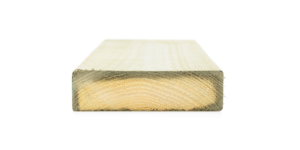A look at the latest innovations and experiments in the field of wood preservation.
Latest wood preservation and nano technology research
The application of ‘nano technology’ is working its way into the area of wood preservation, with two recent research articles highlighting novel processes involving nano technology for introducing preservative compounds into timber.
The first study looked at using polymeric nanoparticles of chitosan to act as a carrier for permethrin into timber from Hevea brasiliensis, the Para rubber tree.1 Chitosan is a biodegradable, biocompatible polymer that is regarded as safe for human consumption and is also used in wound dressings. It has already been used in nanoparticles for drug delivery. The researchers developed a process whereby permethrin-chitosan nanoparticles were delivered through a water-based vacuum pressure treatment. Not only did the treated wood have a high level of resistance to termite attack, but this new methodology halved the pressure and time requirements compared to producing permethrin treated wood through traditional processes.
The second study focused on the challenges of improving the functionality of fabricated wood (e.g. plywood). The wood used in such products often has low fungal and termite resistance (e.g. poplar wood) and so preservatives need to be incorporated into the finished product either through treating the timber and/ or including additives to the glue. A research group inspired by biomineralization – whereby living organisms can produce organic-inorganic hybrid composites – have started looking at the option of in situ mineralisation as a process for introducing preservatives into wood.2
Mineralisation of wood generally occurs with silicates, phosphates, borates and carbonates, with much of the research focusing on calcification. This research group focused on zinc borate as a mineralisation option due to its potential for fungal, termite and even fire resistance. The challenge in the manufacture of functional mineralised wood is to ensure the mineral is of small enough size to be evenly distributed in the nanoporous cell walls to achieve functional efficiency. This is even more difficult for zinc borate, which is not water soluble.

The solution was a two-step process. Firstly, the introduction of a solution of disodium tetraborate decahydrate, zinc sulphate heptahydrate and ammonium water into the wood under vacuum/pressure. Secondly, the ammonia was volatilised causing nanosized zinc borate particles to be synthesises in situ. The resulting wood had significantly improved properties with respect to fire and mould resistance, with termite resistance trials showing negligible weight loss and 100% mortality of termites.
1 Kadir, Roszaini & Li, Wong & Mat Arip, Mohamad Nasir & Lee, Hooi- Ling. (2023). Incorporation of permethrin into chitosan polymeric nanoparticles using nanoprecipitation method for rubberwood preservation against termite attack. Wood Material Science & Engineering. 18. 1-11. 10.1080/17480272.2022.2164741.
2 Zhou, Haiyang & Wen, Dongxian & Hao, Xiaolong & Chen, Chuanfu & Zhao, Nianhan & Ou, Rongxian & Wang, Qingwen. (2022). Nanostructured multifunctional wood hybrids fabricated via in situ mineralization of zinc borate in hierarchical wood structures. Chemical Engineering Journal. 451. 138308. 10.1016/j.cej.2022.138308.
Termite Professional Australian edition, 2022
Heat treatment for wood preservation
Heat treatments and hydrothermal processes, whereby timber is treated to a specified temperature in the presence of steam or liquid water under pressure, are a focus of research. Whilst these treatments often deliver improvements in dimensional stability by removing hydroxyl groups from the timber — thus making it more hydrophobic and less prone to swelling — many of the techniques reduce the strength of the timber. However, it appears that treatment media that is neutral or alkaline buffered, results in a minimal decrease in wood strength, especially if the treatment temperature does not exceed 180°C. Heat treatment does however darken the wood, although this is often beneficial in some uses (flooring and furniture). However, the optimal process for each type of timber will need to be developed, as different species often respond differently to the same treatment.1
The benefits of heat treatment can be illustrated by recent studies on short rotation teak (7-10 year harvest period), which is a poor quality timber relative to long rotation teak (40-60 year harvest period), especially with reference to its reduced density and durability.2 Even a basic heat treatment process delivered an improvement in anti-swelling efficiency (dimensional stability) of up to 46.7% and good durability against termites (rating 9/10) and decay (rating 10/10). Impregnation of the timber with a 10% w/w solution of glycerol-maleic anhydride increased the anti-swelling efficiency by up to 73.2%, with top ratings for decay and termite durability.3
The variability in the benefits of heat treatment on different species is highlighted by recent research on Pinus roxburghii (chir pine or longleaf Indian pine), which is a timber susceptible to fungal decay and termite attack. Although heat treatment improved the anti-swelling efficiency and its resistance to fungal decay, it had no impact on its susceptibility to termite attack.4 However, the same researchers established that a combination of citric acid chemical modification followed by heat treatment did deliver a significant improvement in resistance to both fungal decay and termite attack.
New wood preservation chemicals
Of course, the industry is always on the lookout for alternative wood preservative chemicals that have a more favourable environmental profile. One interesting option that has arisen is the use of caffeine. Researchers in the Czech Republic have demonstrated that caffeine can provide the same level of protection against brown rot fungus and termites (Reticulitermes flavipes) as commercial biocides.5 However, the long-term protection in exposed situations is unlikely due to its high leaching potential. On the flip side this means the timber can be treated with caffeine using a simple and cheap, long-term dipping technology. The researchers believe its potential for the protection of wood for indoor use should be explored further.

Following a general trend of examining essential oils for their potential in insect control, researchers are also taking a closer look at lavender oil. Investigating its potential for protecting Norway spruce, one study indicated that a lavender oil treatment gave a level of termite protection close to that achieved with a commercial product containing a combination of boron and quaternary ammonium salt.6 Adding an additional hydrophobic treatment delivered full termite resistance, even after artificial weathering. However, lavender oil failed to provide any protection against wood decay (brown rot).
References
1 Ali, Md. Rowson & Abdullah, Ummi & Ashaari, Zaidon & Hamid, Norul & Lee, Seng Hua. (2021). Hydrothermal Modification of Wood: A Review. Polymers. 13. 2612. 10.3390/polym13162612.
2 Martha, Resa & Basri, Efrida & Setiono, Loedy & Batubara, Irmanida & Rahayu, Istie & Gérardin, Philippe & Darmawan, Wayan. (2021). The effect of heat treatment on the characteristics of the short rotation teak. International Wood Products Journal. 12. 1-10. 10.1080/20426445.2021.1953723.
3 Martha, Resa & Mubarok, Mahdi & Batubara, Irmanida & Rahayu, Istie & Setiono, Loedy & Darmawan, Wayan & Akong, Firmin & George, Béatrice & Gerardin, Christine & Gérardin, Philippe. (2021). Effect of glycerol-maleic anhydride treatment on technological properties of short rotation teak wood. Wood Science and Technology. 55. 1-25. 10.1007/s00226-021- 01340-3.
4 Samani, Ajmal & Ganguly, Sauradipta & Hom, Sanjeet. (2021). Effect of chemical modification and heat treatment on biological durability and dimensional stability of Pinus roxburghii Sarg. New Zealand Journal of Forestry Science. 51. 15. 10.33494/nzjfs512021x143x.
5 Šimůnková, Kristýna & Reinprecht, Ladislav & Nábělková, Jana & Hýsek, Štěpán & Kindl, Jiří & Borůvka, Vlastimil & Lišková, Tereza & Šobotník, Jan & Panek, Milos. (2021). Caffeine — Perspective natural biocide for wood protection against decaying fungi and termites. Journal of Cleaner Production. 304. 127110. 10.1016/j.jclepro.2021.127110.
6 Šimůnková, Kristýna & Hýsek, Štěpán & Reinprecht, Ladislav & Šobotník, Jan & Lišková, Tereza & Panek, Milos. (2022). Lavender oil as eco-friendly alternative to protect wood against termites without negative effect on wood properties. Scientific Reports. 2022. 1909. 10.1038/s41598-022- 05959-5.
Termite Professional Australian edition, 2021
Nanoparticle fluorides for wood protection
Traditional wood preservatives are commonly copper, boron or arsenic based. Not surprisingly there is significant research into better, less toxic ways to treat wood to protect it from decay and timber pests.
New preservation methods such as wood modification techniques, including acetylation, have been evaluated. Acetylation chemically modifies the wood, reducing moisture content to a level that cannot support decay. It also makes the wood stronger, but it doesn’t appear to be completely resistant to all species of termite. Another avenue is using nanoparticles for increased penetration of preservatives into the wood. This technique certainly appears to boost the performance of the traditional wood preservatives. Specifically, researchers have started to evaluate the use of nano metal fluorides as a wood preservative.1

Sodium fluoride is known to have potential as a wood preservative, and may even be superior to traditional preservatives. Indeed, fluorides in general have the benefit that they are effective at low concentrations. However, on the downside, sodium fluoride readily leaches from wood when wet. The reduction in efficacy coupled with the environmental impact of leaching means the use of sodium fluoride commercially is somewhat problematic.
However, in this latest research, scientists have evaluated the use of low water soluble fluorides (magnesium and calcium fluoride), synthesised as nanoparticles to gain penetration into the timber. Samples of Scots pine sapwood (Pinus sylvestris) treated with the experimental solutions were exposed to Coptotermes formosanus for eight weeks. Wood treated with 0.5 M concentration solutions of either fluoride provided 100% mortality of termites.

Weight loss due to consumption by termites was minimal (less than 1%), with combinations of calcium and magnesium fluoride potentially providing the best performance. The authors concluded that nanoparticle fluorides certainly have potential as wood preservatives.
1 Usmani, S.M., Plarre, R., Huebert, T., Kemnitz, E., 2020. Termite resistance of pine wood treated with nano metal fluorides. EUROPEAN JOURNAL OF WOOD AND WOOD PRODUCTS 78, 493–499. https://doi.org/10.1007/s00107-020-01522-z



